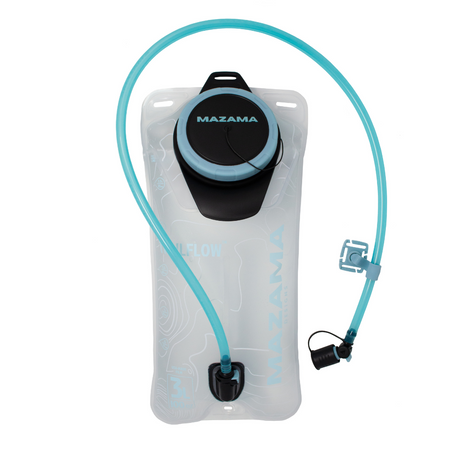Give Your Hydration Gear Some Love: How to Clean Your Bottles and Reservoir
February 21 2022 – Matt Hoskins

With spring coming up, it’s time to give some love to your hydration gear.
When spring rolls around and it’s time to hit the trails, you don’t want to stop to deal with dirty, moldy bottles or leaking hydration reservoirs. First, it’s a pain — when that fresh spring breeze welcomes you back outside, you want your gear to be ready to get back on the trail.
Second, it’s… gross. A neglected bottle or reservoir could be harboring harmful bacteria that you definitely don’t want to drink.
And third, taking care of your bottles and reservoirs will extend their life so you don’t have to replace them as often.
So as you’re spreading the love this Valentine’s Day, be sure to care for your hydration gear, too. And when it’s time for your favorite springtime activities, you and your gear will be ready to go.

Hydration Gear Cleaning and Care Considerations
Both your bottles and reservoirs need regular, thorough cleaning to keep them in good shape. Water bottles are fairly easy to clean, but easy to ignore, too. Most of us tend to refill our bottles when they’re empty rather than wash and dry them in between. How many water bottles do you have rolling around in the backseat of your car or hidden in the bottom of your day pack? It’s time to gather them up and give them a thorough washing.

You might neglect to clean your reservoir, too. Whether you have a top-fill or a screwport reservoir, they aren’t as easy to clean. It’s tempting to just fill it back up whenever it’s empty. But your hydration reservoir — especially when used (and cleaned) infrequently — is the perfect place for bacteria to take hold.
Gather your bottles and your hydration reservoir, and we’ll walk you through a simple yet effective cleaning process.
How to Clean Your Hydration Gear
So how do you clean your hydration gear to keep it clean and in good shape? Depending on what you’re cleaning — a hard-sided bottle, a soft bottle, or a reservoir — you’ll need different supplies and strategies.
Bottles
Whether you have a soft- or hard-sided bottle, check first to see if it’s dishwasher safe. Running your bottles through the dishwasher is an easy way to get them clean, but some bottles require hand washing. And if you’re one to cover your bottles in all kinds of stickers, hand washing will keep them around longer.
Bottles come in all shapes, sizes, and materials, but this cleaning process works for any type.
Supplies:
- Bottle brush
- Dish soap
- Warm water
- Cleaning tablets, white vinegar, or bleach
Steps:
- Fill your bottle with hot water and a little bit of soap.
- Put the lid on the bottle and shake it.
- Dump out the soapy liquid, then use a bottle brush to scrub all the surfaces — don’t forget the lid!
- Rinse well and dry.

If you’ve been neglecting your bottle for a long time, you might need a deeper clean (and some odor control). Try these steps:
- If using cleaning tablets: Fill your bottle with warm water and drop a cleaning tablet in. Leave it alone for 30 minutes, then empty and rinse your bottle.
- If using white vinegar: Fill your bottle a quarter full with vinegar, then add water until it’s half full. Shake the bottle, then let it sit overnight before emptying and rinsing it. If there’s an unpleasant vinegar-y smell, scrub with soap, rinse, and dry.
- If using bleach: Fill your bottle with warm water until it’s about two-thirds full. Add a few drops of bleach, then give it a shake. Let it sit for an hour, then use a bottle brush to scrub all the surfaces. Rinse, dry, and you’re good to go.
The more often you clean your bottles, the less frequently you’ll need to deep-clean them. But anytime you neglect one too long — or it starts to smell funky — take the extra steps to deep-clean.
Reservoirs
As tempting as it is to leave your reservoir in your pack, you should empty and dry it after every use. Letting your reservoir dry completely is key to keeping bacteria from growing inside.
While you don’t have to clean it after every use, you should clean your hydration reservoir every once in a while — especially before putting it away for extended periods of time and when you get it out of storage.
Check with the instructions that came with your reservoir to see if it’s dishwasher safe. Otherwise, follow these instructions to clean it by hand:
Supplies:
- Bottle brush or reservoir brush
- Thin, knotted cord or drink tube brush
- Hanger or clothespins for drying
- Cleaning tablet or bleach
Steps:
- Rinse out your reservoir by filling it with water and emptying it a couple of times.
- Fill your reservoir about halfway with water, then drain it through the drink tube. You’ll need to hold the reservoir up high and pinch the mouthpiece of the drink tube to get it to drain.

- Scrub everything! Use a bottle brush or reservoir brush to scrub the inside of the reservoir. Use a drink tube brush or a knotted cord to scrub the inside of the drink tube. Finally, take apart the bite valve to scrub its interior.
- If using a cleaning tablet: Fill your reservoir with water and drop the cleaning tablet in. Let it soak for 30 minutes, shake, then drain through your drink tube.
- If using bleach: Mix one tablespoon of bleach per liter of water in a separate container, then pour into your reservoir. Drain a little of the mixture through your drink tube, then let it sit for an hour. Drain through your drink tube.
- Rinse and drain the reservoir and drink tube several times to get rid of all of the cleaning solution.
- Use a hanger or clothespins to hang your reservoir upside down for drying. If you don’t have a drying frame, you can prop the reservoir open with a kitchen utensil or paper towels.

Remember, the most important part of keeping your reservoir bacteria-free is to make sure it dries completely before putting it away. Remember, the most important part of keeping your reservoir bacteria-free is to make sure it dries completely before putting it away. Check out Mazama's Reservoir Cleaning Tips video here.
A great way to ensure complete drying is to use the BŌNDRY, reservoir dryer. This insertable pad from our friends at Fossil Outdoor uses advanced moisture transport technology to efficiently remove liquid from hydration bladders, insulated bottles, soft flasks and other hard to dry locations to keep them funk free!

Clean Your Hydration Gear for the Season Ahead
We know hydration reservoirs aren’t the easiest thing to clean, but we know how important it is. We designed our Cleaning and Drying Kit to make this process easy and hassle-free.

Give some love to your gear pre-season with a thorough cleaning and maintenance check. Your gear will last longer, your water will taste better, and you’ll be ready to hit the trail as soon as spring arrives.

